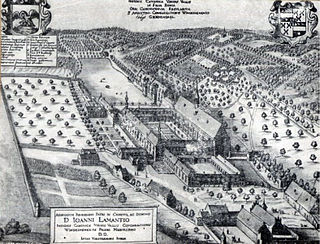
The Order of Canons Regular of Prémontré, also known as the Premonstratensians, the Norbertines and, in Britain and Ireland, as the White Canons, is a religious order of canons regular of the Catholic Church founded in Prémontré near Laon in 1120 by Norbert of Xanten, who later became Archbishop of Magdeburg. Premonstratensians are designated by OPraem following their name.

The Sonian Forest or Sonian Wood is a 4,421-hectare (10,920-acre) forest at the south-eastern edge of Brussels, Belgium. It is connected to the Bois de la Cambre/Ter Kamerenbos, an urban public park which enters the city up to 4 kilometres (2.5 mi) from the city centre.

Ixelles or Elsene is one of the 19 municipalities of the Brussels-Capital Region, Belgium. Located to the south-east of Brussels' city centre, it is geographically bisected by the City of Brussels. It is also bordered by the municipalities of Auderghem, Etterbeek, Forest, Uccle, Saint-Gilles and Watermael-Boitsfort.

Stanbrook Abbey is a Catholic contemplative Benedictine Monastery with the status of an abbey, located at Wass, North Yorkshire, England.

La Cambre Abbey or Ter Kameren Abbey is a former Cistercian abbey in the City of Brussels, Belgium. It is located in the Maelbeek valley between the Bois de la Cambre/Ter Kamerenbos and the Ixelles Ponds. The abbey church is a Catholic parish of the Archdiocese of Mechelen–Brussels and home to a community of Norbertine canons, while other parts of the monastery house the headquarters of the Belgian National Geographic Institute (NGI) and La Cambre, a prestigious visual arts school.

The Marolles or Marollen is a popular historic neighbourhood of downtown Brussels, Belgium. It is situated between the Palace of Justice to its south-east, the Chapel Church to its north and the Halle Gate to its south. Its inhabitants are called Marolliens in French and Marollianen in Dutch.

Keizersberg Abbey, also known as Mont César Abbey is a Benedictine monastery on the hill Keizersberg or Mont César in the north of the university town of Leuven, Belgium.

Munsterbilzen Abbey was an abbey of Benedictine nuns in Munsterbilzen, Limburg, Belgium, founded in around 670 by Saint Landrada. It was plundered by Vikings in 881 but restored. From the 9th century it was dedicated to Saint Amor.

Herkenrode Abbey was a Catholic monastery of Cistercian nuns located in Kuringen, part of the municipality of Hasselt, which lies in the province of Limburg, Belgium.

Forest Abbey or Vorst Abbey was a Benedictine abbey located in the Brussels municipality of Forest, Belgium. It was founded in 1105 and existed for nearly 700 years, until its partial destruction by fire in 1764. It was abolished in 1796. Only the abbey's 18th-century outbuildings have been preserved. They are now owned by the municipality and serve as a cultural centre.

Groenendael Priory is located in the Sonian Forest in the municipality of Hoeilaart in Flemish Brabant, about 10 kilometres (6.2 mi) south-east of Brussels, Belgium.

Ten Putte Abbey is a monastery with an abbey in Gistel, roughly 8 km to the south of Ostend, in the western part of Belgium. It was built to mark the spot where, in 1070, Saint Godelina was murdered by strangulation and then thrown into a pond. Before 2007 the abbey was home to nine Benedictine nuns, who were members of the wider Subiaco Cassinese Congregation in West Flanders. Since 2007 it has been occupied by brothers and sisters of the "Mother of Peace" community.

Maredret Abbey, also known as l’Abbaye des saints Jean et Scolastique, is a monastery of Benedictine nuns located on the edge of Maredret, a very small village in the hilly countryside to the south of Charleroi and Namur, Wallonia, Belgium. The abbey was inaugurated with the installation of seven nuns in 1893, and the abbey church was constructed between 1898 and 1907.
Sibculo Abbey, also called Groot Galilea, was a Cistercian abbey founded in 1403 by followers of the Modern Devotion movement and dissolved in 1579 during the Protestant Reformation of the Netherlands. Its remains are near the village of Sibculo in the municipality of Hardenberg in Overijssel.
Ida of Louvain was a Cistercian nun of Roosendael Abbey in the 13th-century Low Countries who is officially commemorated in the Catholic Church as blessed.

Ermeton Abbey is a monastery of Benedictine nuns in a medieval castle in the village of Ermeton-sur-Biert, Wallonia, Belgium.

Oosteeklo Abbey was a Cistercian nunnery founded in Oosteeklo in 1217 and later moved to Ghent.

Altbronn Abbey or Our Lady of Mercy Abbey is a former Trappistine nunnery in Ergersheim, Bas-Rhin, northeastern France.
Bernardusdal Abbey was a house of Cistercian nuns originally established just outside Diest in the Duchy of Brabant, and later within the walls of the town itself.
















